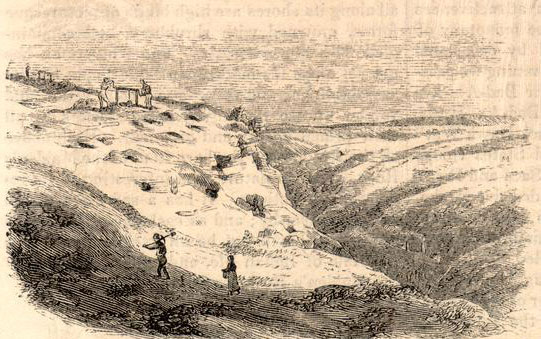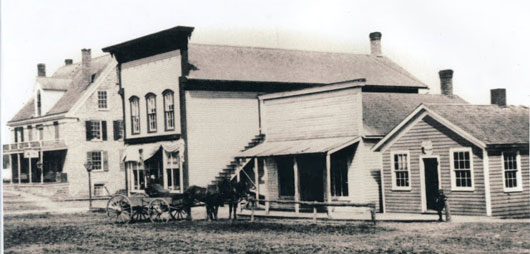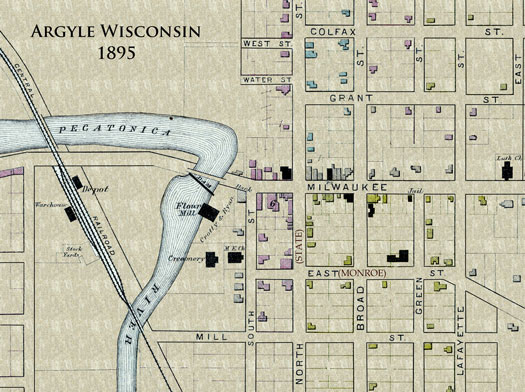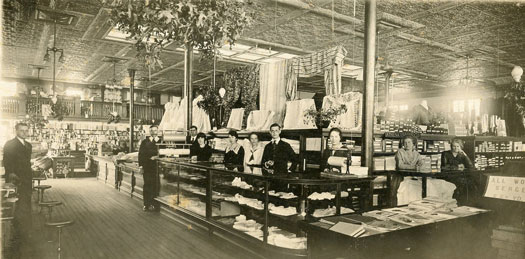Early Settlement
The Story of the Land

The history of Argyle begins with the early settlement history of the area now known as southwest Wisconsin. This area escaped the effects of the Wisconsin glacier, some 10,000 years ago, and has come to be known as "the Driftless Area". It is a beautiful and unique area, whose attributes and resources are described on a map drawn by RW Chandler in 1829 which was intended to lure early settlers, specifically miners, from the east.
This tract of country from the high lands is gently rolling, but as you approach the larger water-course it becomes more and more hilly, terminating in high calcareous bluffs along their margins. About one third is first rate farming land. Not more than a tenth is covered with timber, which grows in detached groves, the balance prairie. Springs of the purest water are to be found in abundance. The interior is healthy, no local causes of fever exist, except immediately on the Mississippi. The climate is pleasant and desirable, except during the spring months. Snow seldom exceeds 12 inches in depth during winter. All the fruits, vegetables and grains which grow in the same lattitude in our Eastern States would succeed equally here. The mounds delineated on the map are natural formations rising several hundred feet above the level of the country, some one of which may be seen from almost every part of the mines, serving as natural beacons to direct the traveller in his course.... Excerpt from Map of the United States Lead Mines on the Upper Mississippi River, drawn by RW Chandler, 1829
The Story of the Miners

While it is known that the French fur trader, Nicholas Perrot, actively traded lead mined by the Indians in the late 1600's, it was not until the Indians ceded all lands south of the Wisconsin River in the early 1800's that it was safe for miners of Scotch, Irish, Welsh, and Cornish descent to settle here in the 1820's. The first miners in the area discovered lead in deposits close to the surface, which when extracted left "badger holes" that provided shelter to the earliest settlers. Settlement quickly expanded as there was strong demand for lead which at the time was used in the manufacture of paint, pipes, ammunition and pewter. By 1829, more than 4,000 miners worked in southwest Wisconsin, producing 13 million pounds of lead per year. Among those was William S. Hamilton, son of U.S. Treasury Secretary Alexander Hamilton, who established Hamilton's Diggings a short distance from Argyle in what is now known as Wiota. At first, lead was transported to Galena and shipped down the Mississippi River. After the construction of the Erie Canal, teams of 8 oxen were used to haul lead to Milwaukee, where it could be shipped via the Great Lakes and canal to eastern markets. The muddy, rutted road to Milwaukee followed an old Indian trail and became known as the Lead Road. The Lead Road forded the Pecatonica River at the future location of Argyle.
The Settlement on the River

The Argyle settlement began as a river fording located on the Lead Road. It was named in 1844 by Allan Wright, blacksmith and first postmaster, in honor of the Duke of Argyll of his native Scotland.
Earliest dwellings in Argyle were located along the road to lead mines in Fort Hamilton (Wiota) and the platting of land in 1850 was done with the assumption that growth would take place there. However, the construction of a saw mill (1850), a flour mill (1852), a hotel (1853) and various stores on the east bank of the Pecatonica led to growth of the village there and Argyle's west side was not developed until the construction of the Freeport-Dodgeville and Northern railroad in 1887.
The earliest commercial buildings were constructed of local limestone, as lumber was scarce. Very few traces of Argyle's "Stone Age" (early 1850s) exist today.
Development
A Settlement Becomes a Village

With the discovery of California gold in 1849 and diminishing returns from Wisconsin lead mines, most of the miners who initially settled this area headed west. About the same time, crop failures led to hard times in Europe (starving '40's) which created incentive for farmers to emigrate to America. Many of these immigrants sought out new homesteads in surroundings similar to their native land. Such was the case with Norwegians who emigrated to southwest Wisconsin in and around a settlement on the Pecatonica River known as Argyle.
In those days, a bend in the river at the site of the settlement lent to fording it, but a limestone bluff on the east side of the river initially discouraged any development there. In 1852, a part of the bluff was whittled away to make way for a flour mill, and due to frequent flooding on the west side and construction of the first bridge in 1855, development "up the hill" on the east side of the river was increasingly favored.
Just 30 years later, the village now with a population of approximately 500 was bustling with a newspaper, four general stores, two hotels, a cabinet shop, a livestock buying business, a livery, blacksmiths, gunsmiths, and coopersmiths. In these days and those following, Argyle was both a hub for local farming and dairying, as well as a crossroads for travelers and business alike.
The Coming of the Railroad

Serious discussion of a rail line linking the Pecatonica River valley with Freeport and Chicago began in 1884 and culminated with the charter of the Freeport, Dodgeville and Northern Company in 1887. The proposed 57 mile route would require 29 crossings of the winding Pecatonica River and would pass through the villages of Woodford, Argyle, Blanchardville, and Hollandale, supporting their continued development. Despite the obstacles, work proceeded rapidly and passenger service was established in February, 1888. The addition of the rail link further stimulated Argyle business with the creation of a stock buying and shipping business, lumber yard, warehouse for storage of coal, lime, cement and feed, plus new creameries producing butter and cheese. Local retail merchants benefitted from the connection to big city suppliers, while hotels, restaurants and liveries benefitted from arriving travelers.
The 1890's

Nationally, the 1890s were a time of severe recession, which started with the Panic of 1893; however, Argyle weathered this storm fairly well. Indeed, the village prospered with a growing number of businesses and, by 1897, a shortage of housing. In 1895 James S. Waddington and sons opened Argyle’s first bank with over $40,000 ($1.2m) in assets, which more than quadrupled by the turn of the century. The same year the town replaced the single-lane “wagon bridge” with a much wider and stronger iron bridge. Earlier in the decade, L. A. Rossing doubled the size of his store and M. J. Rude put up a new larger building to house his growing shoe repair and sales business. The grist mill was busier than ever, but the opening of the lumber yard in 1888 put the adjacent lumber mill out of business. Randall and James Buckmaster took over the jewelry store from A. E. Thoreson and expanded into optical and musical goods, and even bicycles; Charles Haldeman opened a meat market next to the City Hotel; J. R. Threadgold and son opened a warehouse next to the train depot and traded in livestock and farm implements; John Wahler opened a barber shop between Rossing’s store and the Saxton house; and the Thompson brothers from Fayette took over the livery stables. In 1898 Dr. C. A. Hansen put up a new brick drugstore with his offices on the second floor.
All this prosperity was mainly due to the arrival of the long-awaited railroad service, which started in 1888 and opened up the Chicago markets for butter, cheese, eggs, livestock, cordwood, and even ice. The creamery, built by Elgin, Illinois entrepreneur John Newman in 1890, produced butter year-round at a time that most cheese factories closed for the winter. On Mondays, the day livestock was shipped out of the Argyle depot, the town was usually full of farmers from surrounding areas, especially Fayette, Lamont, and Willow Springs bringing their hogs and cattle, and filling up Argyle’s three hotels. On a good day, stock dealer A. G. Hawley would ship 15 cars of livestock to the Chicago markets. Another reason the local population did not suffer much from the recession was that the farmers were quite self-sufficient, raising much of their own food and relying on large families for labor. Land was relatively cheap at that time averaging $45 ($1,300) per acre—about the same price as a milk cow—and lots in Argyle went for about $350 ($10,000).
The November 1896 presidential election between Republican William McKinley, who advocated the continuation of laissez-faire economic policies, and the populist Democrat William Jennings Bryan, who wanted to rein in big businesses and the railroads, was hotly debated in the Argyle area. After McKinley won in a landslide, the Argyle Atlas reported on enthusiastic celebrations in Argyle and Blanchardville which drew many people into the streets, and included local brass bands, glee clubs, fireworks, speeches, a dance, and a parade with many lively floats and thirty white horses. The recurring issue that dominated the local April elections was whether the town would be wet or dry—“license or no license.” Argyle remained dry throughout the decade, except for 1894 and 1895. This trend continued into the next century, and of course became national with the ratification of the 18th amendment in January 1919.
This was an interesting period in Argyle history, which has been captured in the form of an interactive map of the village in 1895.
A New Century

Argyle’s prosperity of the 1890s continued into the new century with increased optimism for future growth and innovation. One who shared this optimism was the indefatigable Atlas publisher George G. Gaskill. In various articles since taking over the paper in 1885 he had been advocating for many village improvements, such as good schools, more housing, local telephone service, electric street lighting, a waterworks system, village incorporation, and a new cemetery. All of these, and more, came into being over the next sixteen years leading up to World War I.
In 1903, after an incorporation referendum passed, Frank A. Waddington, son of J.S. Waddington, was elected the first village mayor. This allowed the newly formed village council to implement many needed improvements—the first being the leveling of main street and replacing the old uneven boardwalks with cement walks throughout the business district and into some of the residential areas.Two years later, the village council raised $15,000 to install a power plant and waterworks. In November 1906, mayor John Powell ceremoniously switched on the long awaited street lights. In July 1913, the village tested its newly installed waterworks system by hooking up hoses to fire hydrants placed around the village and a month later, twenty-one local men organized a volunteer fire department which Gaskill crowed was “second to none.”
This era also saw the addition of many substantial buildings, most of which still stand today. After Dr. Hansen built his two-story brick drugstore (1898), J.J. Uren started construction on a large solid brick store just east of the Hansen drugstore(1905). L.A. Rossing built a “grand new store on the corner,”(1911) which necessitated moving the historic Saxton house two blocks north. The Phillipson brothers put up an equally impressive garage(1915) with a large hall on the second floor. The so-called “Opera House” took over from Partridge’s Hall and housed dances, graduations, wrestling matches, plays, movies, and even served as the basketball court for the Argyle schools. Below in the garage, the Phillipson brothers were doing very good business selling Model T touring cars for $490 and Ford tractors to local farmers who enjoyed what is often referred to as "The Golden Age of Agriculture".
Despite events in Europe leading up to world war, 1915 was a very eventful and prosperous year for Argyle. The village started all-day electrical service, cement walks were extended to many parts of the village, the new Commercial Bank announced a quadrupling of its assets, the L.A. Rossing Company opened branch stores in Lamont and Fayette, and Phillipsons tripled their sales of cars from a year earlier, contributing to a doubling of cars registered within the village. All this, and much, much more, changed after Congress declared war on Germany in April 1917.
Read more about this eventful segment of Argyle history in Greg Rossing's complete and informative article.